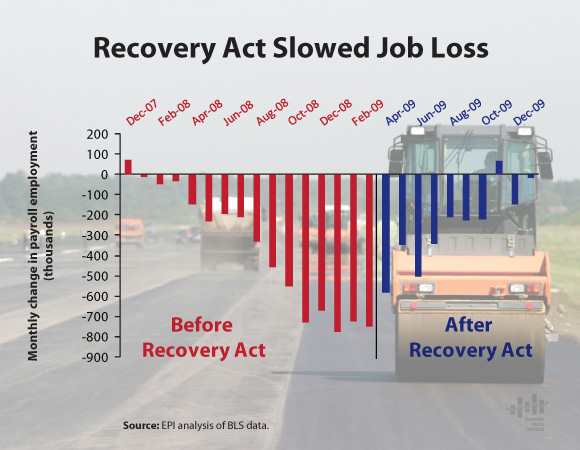 The Recovery Act is working
The Recovery Act is working
One year ago this week, President Obama signed into law the American Recovery and Reinvestment Act. At the time our economy was in free fall, the stock market had tanked, and job losses were topping 800,000 a month. Millions of Americans who lost their jobs were also losing their health insurance and running out of unemployment benefits. The financial collapse caused by Wall St had crippled Main St, and the task of averting another Great Depression was left to the only institution capable of responding: we the people.
In remarks on the first anniversary of signing the Recovery Act, President Obama said of its necessity, "We had a responsibility to do what was right for the U.S. economy and for the American people."
"One year later, it is largely thanks to the Recovery Act that a second depression is no longer a possibility. It's one of the main reasons the economy has gone from shrinking by 6 percent to growing at about 6 percent. And this morning we learned that manufacturing production posted a strong gain. So far, the Recovery Act is responsible for the jobs of about 2 million Americans who would otherwise be unemployed. These aren't just our numbers; these are the estimates of independent, nonpartisan economists across the spectrum."
Millions of unemployed workers have been able to keep their health care coverage because of the generous COBRA subsidies in the Recovery Act and meet basic needs because of the extension of federal unemployment benefits under the Act.
Ninety-five percent of Americans are paying lower taxes because of tax cuts included in the Recovery Act - the largest middle class tax cut, ever.
State governments across the country, while still having to deal with huge budget shortfalls, have averted disaster because of direct aid for teachers, police officers, and firefighters.
Tens of thousands of construction workers idled by the housing and commercial real estate collapse are employed building or improving our state's infrastructure. North Carolina alone was awarded over half a billion dollars to develop high speed rail from Charlotte to Raleigh and on to Richmond - money that came from the Recovery Act.
"Just look at the outside evaluations of the stimulus," says David Leonhardt, economics writer for the New York Times:
"Perhaps the best-known economic research firms are IHS Global Insight, Macroeconomic Advisers and Moody'sEconomy.com. They all estimate that the bill has added 1.6 million to 1.8 million jobs so far and that its ultimate impact will be roughly 2.5 million jobs. The Congressional Budget Office, an independent agency, considers these estimates to be conservative."
"We must not forget the enormity of the damage done to the economy before the Recovery Act," says Ross Eisenbrey at the Economic Policy Institute:
"From December 2007 to March 2009, one out of every twenty private sector jobs was eliminated, a rate of destruction 50% greater than even the severe recession in the early 1980s. With unemployment at 9.7% today, it's hard to appreciate how much more damage the stimulus investments prevented. Without the more than two million jobs generated by the Recovery Act, the unemployment rate would now exceed 11% rather than the 9.7% rate in January."
There's more that must be done to create the number of jobs needed to climb out of the hole we're in. That's why the AFL-CIO is pushing for much greater investment in job creation. Check out the federation's five-point plan to put America back to work here.

